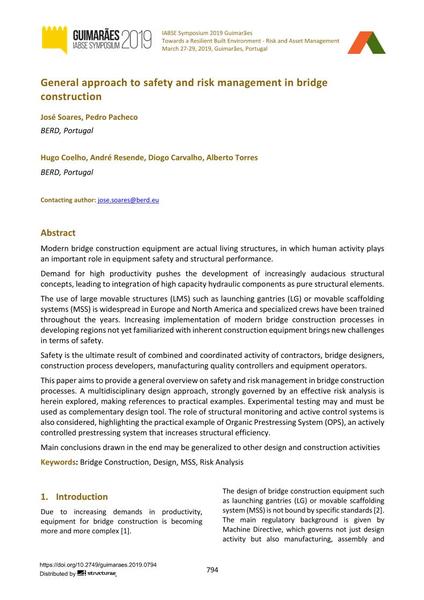General approach to safety and risk management in bridge construction

|
|
|||||||||||
Bibliografische Angaben
| Autor(en): |
José Soares
(BERD, Portugal)
Pedro Pacheco (BERD, Portugal) Hugo Coelho (BERD, Portugal) André Resende (BERD, Portugal) Diogo Carvalho (BERD, Portugal) Alberto Torres (BERD, Portugal) |
||||
|---|---|---|---|---|---|
| Medium: | Tagungsbeitrag | ||||
| Sprache(n): | Englisch | ||||
| Tagung: | IABSE Symposium: Towards a Resilient Built Environment Risk and Asset Management, Guimarães, Portugal, 27-29 March 2019 | ||||
| Veröffentlicht in: | IABSE Symposium Guimarães 2019 | ||||
|
|||||
| Seite(n): | 794-801 | ||||
| Anzahl der Seiten (im PDF): | 8 | ||||
| DOI: | 10.2749/guimaraes.2019.0794 | ||||
| Abstrakt: |
Modern bridge construction equipment are actual living structures, in which human activity plays an important role in equipment safety and structural performance. Demand for high productivity pushes the development of increasingly audacious structural concepts, leading to integration of high capacity hydraulic components as pure structural elements. The use of large movable structures (LMS) such as launching gantries (LG) or movable scaffolding systems (MSS) is widespread in Europe and North America and specialized crews have been trained throughout the years. Increasing implementation of modern bridge construction processes in developing regions not yet familiarized with inherent construction equipment brings new challenges in terms of safety. Safety is the ultimate result of combined and coordinated activity of contractors, bridge designers, construction process developers, manufacturing quality controllers and equipment operators. This paper aims to provide a general overview on safety and risk management in bridge construction processes. A multidisciplinary design approach, strongly governed by an effective risk analysis is herein explored, making references to practical examples. Experimental testing may and must be used as complementary design tool. The role of structural monitoring and active control systems is also considered, highlighting the practical example of Organic Prestressing System (OPS), an actively controlled prestressing system that increases structural efficiency. Main conclusions drawn in the end may be generalized to other design and construction activities |
||||
| Stichwörter: |
Entwurf Brückenbau VSG
|
||||
